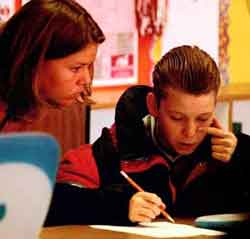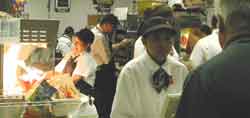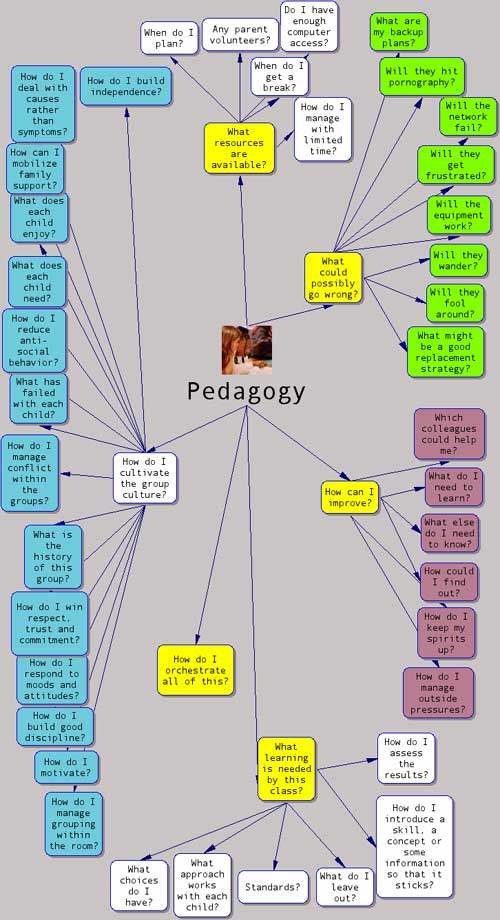|
|
|||||
|
Join Jamie McKenzie at a pre-conference workshop
to explore the ways that teachers can learn to use new technologies. What is the pedagogy they must acquire to make effective use? |
|
|
|
| Vol 13|No 1|September|2003 | |
|
Please feel free to e-mail this article to a friend, a principal, a parent, a colleague, a teacher librarian, a college professor, a poet, a magician, a vendor, an artist, a juggler, a student, a news reporter or anyone you think might enjoy it. Other transmissions and duplications not permitted. (See copyright statement below).
Education Week reported on June 19, 2002 that the Secretary of Education had questioned the importance of teachers learning pedagogy:
The implications of this statement are chilling, especially since a lack of attention to pedagogy (how teachers orchestrate classroom learning) explains why many children bog down in schools or drop out entirely. A lack of devotion to pedagogy also explains why new technologies have failed to realize their potential in many classrooms across the land. The Secretary incorrectly defines pedagogy as "how to be a teacher." In other statements he has dismissed the "art" of teaching and argued for a scientific approach. Roget's defines pedagogy as "The act, process, or art of imparting knowledge and skill." The American Heritage® Dictionary of the English Language defines pedagogy as "The art or profession of teaching." The National Board for Professional Teaching Standards defines pedagogy as follows:
It is because we failed to fund professional development and pretty much ignored pedagogy that many schools have suffered from the screensaver's disease and found little return on their technology investments. A series of reports have identified a severe lack of professional development as a major cause of disappointing results, but even these reports define the task in terms of technology and software training rather than pedagogy.
Too often technology training has shown teachers how to spreadsheet or Powerpoint while failing to demonstrate how these tools might impact learning in their fifth grade classroom, their biology classroom or their art classroom. Schools have offered few courses that focus on classroom management issues or ways to customize learning to match the interests, skills and needs of the learners. We have seen too little focus on curriculum rich strategies. We have too often shown teachers word processing without demonstrating how writing might improve with strategies like those outlined by FNO in a June, 2003 article, "Writing the Right Way" at http://fno.org/jun03/writing.html.
Even though a program like Inspiration™ makes a great companion to a word processor to support writing and thinking, because we tend to teach them to teachers separately, we miss out on much of the learning potential. In contrast with the Secretary's demotion of pedagogy to lesser status, FNO takes the position that we need informed pedagogy now more than ever and that knowledge of content must be balanced with a solid grounding in effective teaching strategies, especially when we hope that teachers will dramatically shift the performance of students who have been failing or struggling. Children are Not Hamburgers and Schools are Not Factories! For several decades schools have been told by outsiders that we could turn around student performance by standardizing instruction and applying business (factory) concepts to schools. This notion is central to many of the strategies for reform imposed on schools by NCLB. Fast food schooling is unhealthy for children. Uniform, regimented teaching of carefully scripted lessons is heralded as the silver bullet to turn around the performance of disadvantaged children, even though we have mounting evidence that much of the data to support so-called "miracles" is doubtful. (See "Cooking the Education Books? Enron Accounting?" at http://www.nochildleft.com/2003/sum03wmd.html and "Fuzzy Math, Fuzzy Reading and Fuzzy Science" at http://www.nochildleft.com/2003/apr03fuzzy.html).
Proponents of fast food schooling claim that poor children respond best to this approach, but the data they advance as proof is unconvincing. Even though some large urban districts in California using this factory strategy have shown good results on standardized tests that are closely related to their commercial textbook programs, startling results achieved by teaching narrowly to these tests curiously did not reappear on the California results for NAEP (The National Assessment of Educational Progress) - a more difficult, more secure test. This failure hints of virtual rather than real gains. Aspects of Pedagogy Worth Considering
An effective teachers must spend much time on strategic questions - pedagogy - how to manage and manage well, how to reach child individually and give her or him the lesson needed.
In a single class period, this teacher reached every student at least once. The cluster diagram below offers a few dozen strategic questions as examples of pedagogy. A failure to address such questions reduces the likelihood that children will make impressive progress. Click on the diagram to view a much larger version in a new window. The above questions may be grouped into several major categories that help to show the importance and scope of pedagogy. Click on any category for an explanation.
Relating Pedagogy For much of the past two decades we have mistakenly focused our energies on the learning of new software and the functions of new tools with too little attention to pedagogy - how to use those new tools effectively to maximize student learning while orchestrating all of the other aspects of daily classroom practice. In this new century and new decade, many teachers and school leaders are awakening to the pre-eminent role pedagogy should play when designing programs and preparing teachers to deliver those programs effectively. Those who design adult learning with the purpose of encouraging appropriate and robust use of new technologies should start their instructional design process by asking how they might help teachers learn strategic classroom practice. Some would argue against this route, dusting off the discredited, insulting and simplistic idea of "teacher proof lessons" that are so highly scripted that "any old fool can get results." In my own thirty-six years of teaching, I have never seen robotic teaching work to the benefit of students, but here we are once again in 2003 hearing false promises of reform based on such simplistic, factory models of schooling. There are few short-cuts that lead to impressive student gains, unless one fudges numbers, teaches to narrowly-defined, insecure tests and ignores the lack of progress on secure tests. Another short-cut unworthy of educators is a system-wide failure to report dropout rates in an honest and accurate fashion or to make sure those students are not left behind or pushed into the street. In the past decade schools were promised that the networking of schools combined with frequent use of new technologies would revolutionize classrooms and bring about a Renaissance of learning. We were led to believe that the purchase of good equipment would allow us to bypass the challenging demands of improving pedagogy. In some respects, technology was advanced as a short-cut, a packaged program, a silver bullet. Three years ago, after attending a national conference promoting laptops for all students, I published an article in FNO, "The New New School Thing," critiquing the exaggerated claims of technology cheerleaders. The following table was included. (See http://fno.org/apr2000/newnew.html)
It is time for schools to recognize such promises as inflated marketing claims. If we want to see the outcomes listed in the table above, we must invest heavily in pedagogy and restrain our fondness for short-cuts, toys and silver bullets. If we hope to see laptops, PDAs, printed books, calculators, questions or any other technologies used effectively, we must put pedagogy ahead of the technology cart. Needs Assessment - What learning is needed? We change student performance by figuring out what each student needs and which strategies will work to unlock patterns that have not been working. Good teachers are very good at diagnosis and the customization of instruction. They keep checking for understanding and they keep searching for the intervention that will enable each student to succeed. They do everything possible to give students good reasons to stay in school and they view each and every dropout as a personal failure. They don't shrug off dropouts as a minor issue. . Professional Growth - How can I improve my teaching? Effective teachers cannot afford to rest or coast for very long because the children have a way of bringing a remarkable new set of challenges into the classroom each day. What worked with some students last year may fail this year. A teacher who stops adding to her or his repertoire of effective strategies is too much like a knife grown dull for lack of sharpening. Classroom Culture - How do I cultivate the class culture for learning? While the importance of emotions and the social aspects of learning are rarely addressed by factory-style reformers, these aspects of classroom life are crucial. If a teacher does not create a culture that is safe, comfortable, encouraging and supportive, learning may not occur. The art of teaching includes the nurturing of group norms that allow learning to thrive. The science of teaching is less effective at reducing fears, freeing dreams and inspiring even disadvantaged students to reach for stars. Strategy - How do I teach to maximize results? Effective teachers possess rich repertoires of instructional moves and techniques. They devote time to matching strategy to situation. But they also understand the trial-and-error aspects of helping students untangle patterns of failure and frustration. It is not a purely scientific process, as even great scientists like Marie Curie sometimes made great discoveries partially by accident (serendipity) and partially by perseverance over thousands of trials and tries. Strong teachers make sure their efforts to match technique to student are guided by intuition, empathy and some of the softer aspects of human knowing. Resource Management - How do I make do with what we have? Shortages of resources are endemic in many classrooms and are often worse in poorly performing schools. Time is always in short supply. But there are many other important resources that can frustrate a teacher's good intentions. These may range from decent, current texts to paper, chalk, adequate heat and insulation from noise. The school may be short on leadership. Morale may be low because of outside threats, the flight of parents and children from the school and bad local press coverage. But good teachers learn to close their classroom doors and make good things happen for children despite these shortages, distractions or threats. Problem Solving - What could go wrong and how do I cope? Life in classrooms is ripe with surprises, but not all of these surprises need to stall forward progress. Smart teachers try to anticipate what might go wrong and have backup plans ready just in case. If the computer network suddenly freezes and a lesson requiring Internet access is suddenly blocked, the teacher immediately asks students to open their class journals (print) and brainstorm questions to pursue once the network recovers. No problem. Orchestration - How do I orchestrate all the different aspects of pedagogy? Some classrooms actually hum with a purposeful, productive energy. The teacher of such classes knows how to combine all of the elements of pedagogy mentioned here so that harmony, resonance and synergy result. Sports psychologists write of the ZONE champion athletes enter that makes remarkable performance possible. The same happens in classrooms when teachers are well schooled in pedagogy. They create a classroom ZONE that makes remarkable performance likely. |
|
Back to September Cover
Credits: The photographs were shot by Jamie McKenzie . Copyright Policy: Materials published in From Now On may be duplicated in hard copy format if unchanged in format and content for educational, nonprofit school district and university use only and may also be sent from person to person by e-mail. This copyright statement must be included. All other uses, transmissions and duplications are prohibited unless permission is granted expressly. Showing these pages remotely through frames is not permitted. FNO is applying for formal copyright registration for articles. Unauthorized abridgements are illegal.
|
 From Now On
From Now On









